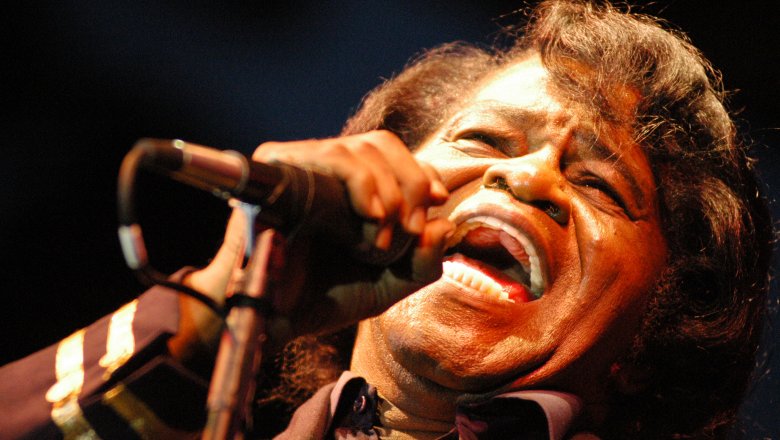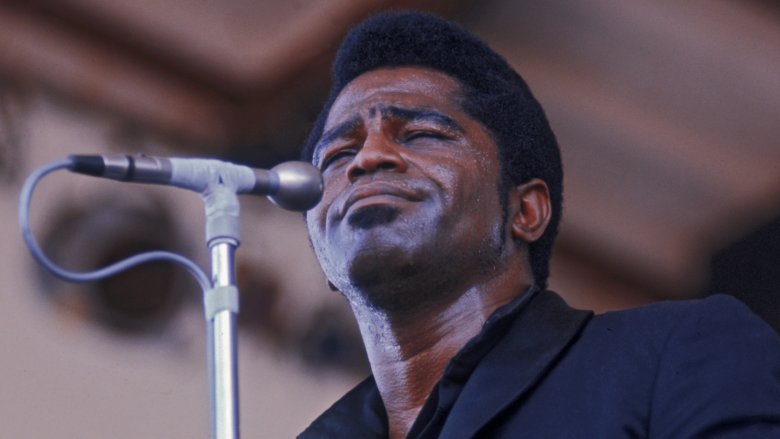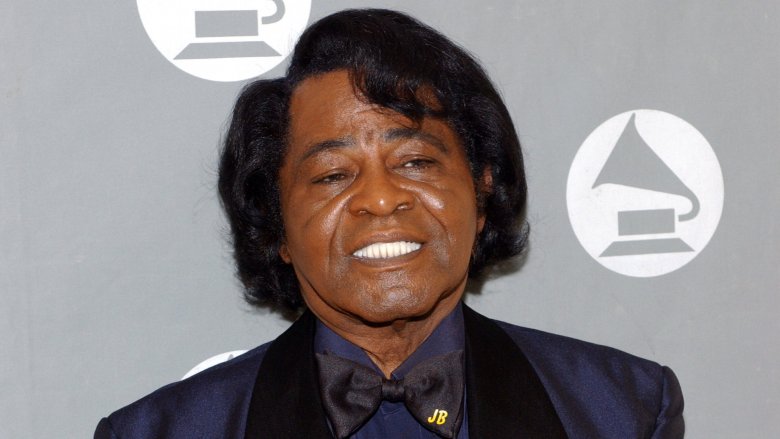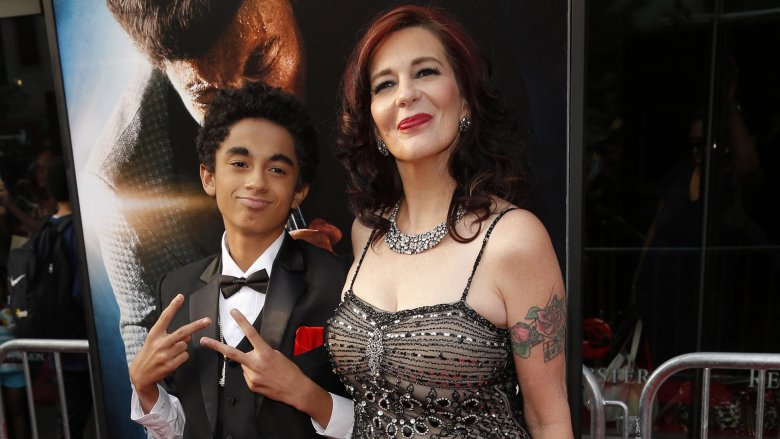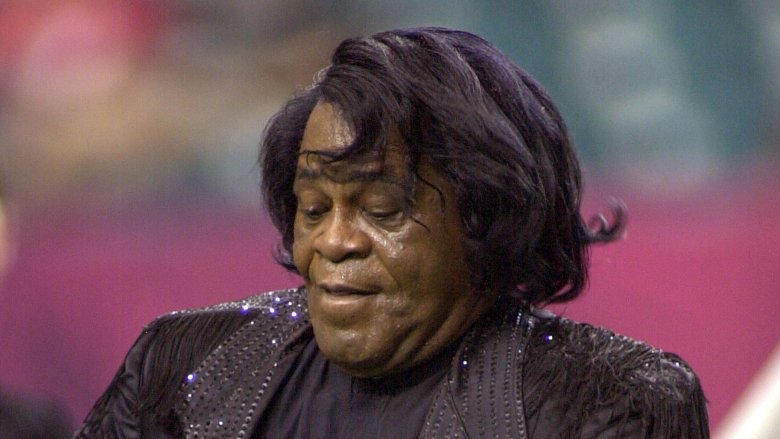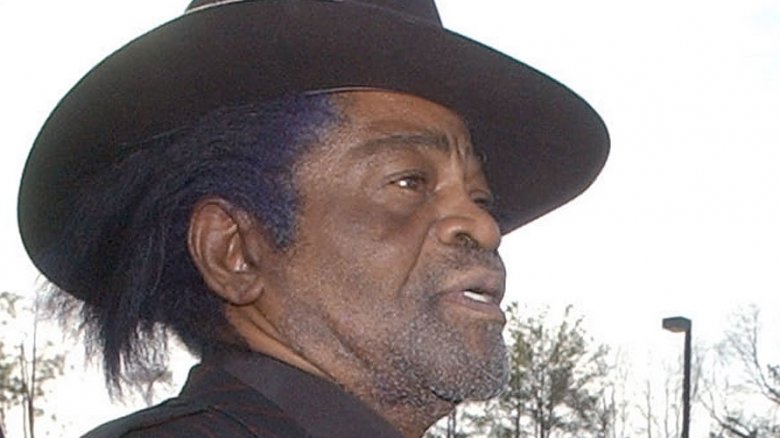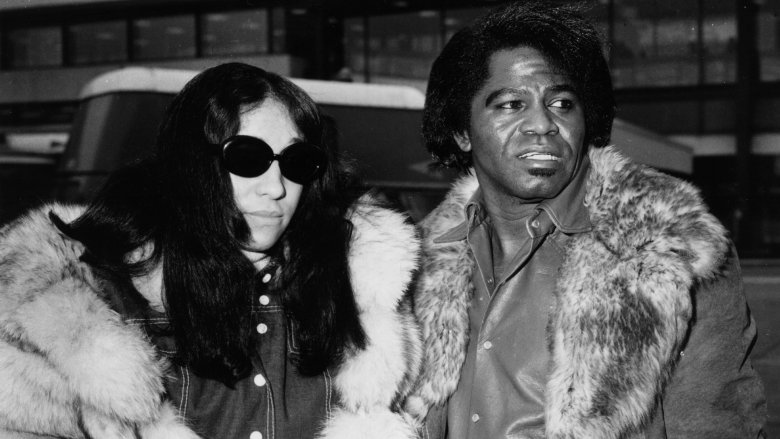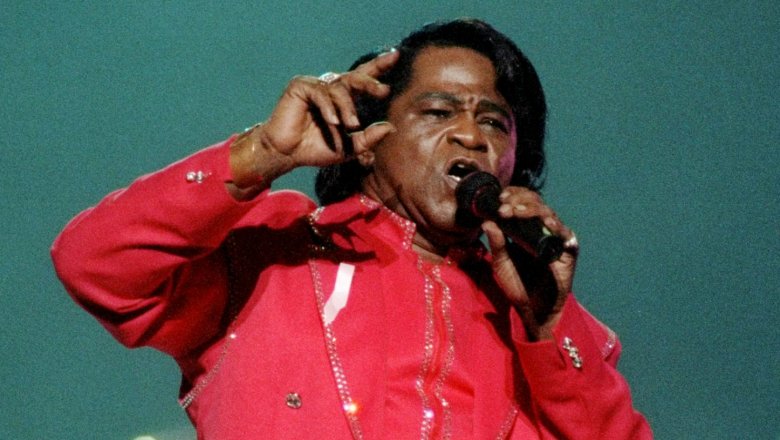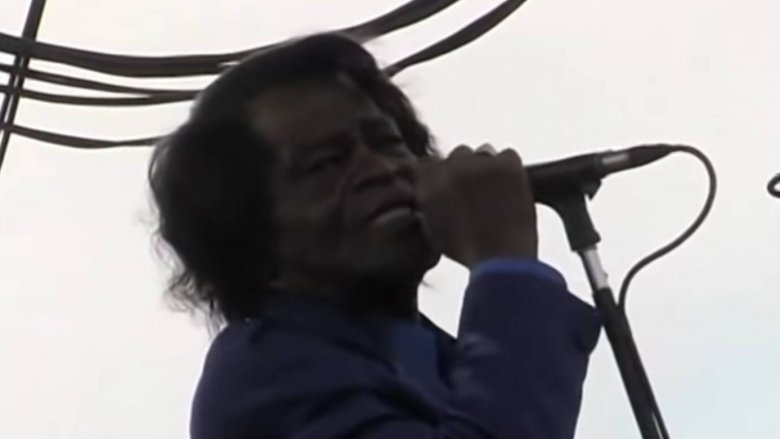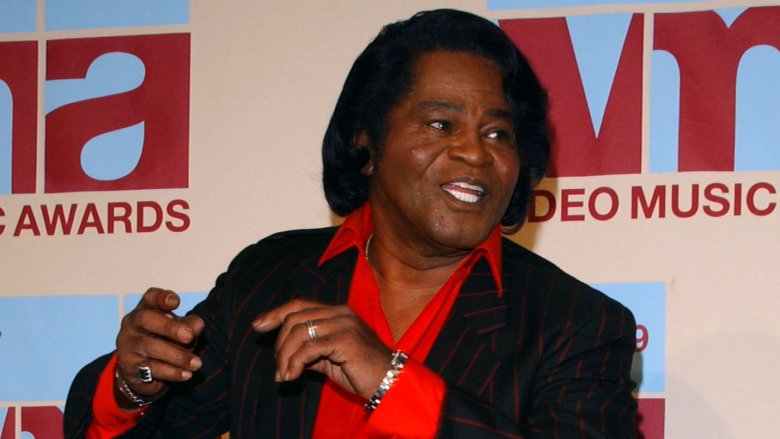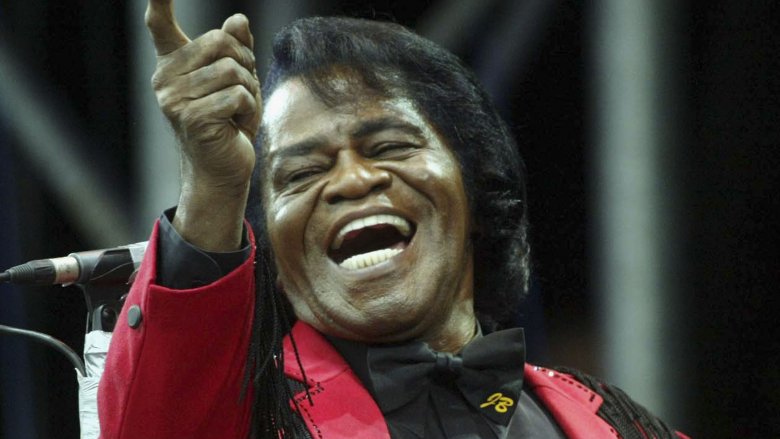What's Come Out About James Brown Since He Died
James Brown worked his way up from almost nothing and ended up with almost everything. Born in a one-room shack in the woods during the Great Depression and partly raised in a brothel, he shined shoes for mere pennies and wore clothes fashioned from sacks. But with his raw, raspy voice, electrifying showmanship, and irresistibly catchy songs, Brown cemented his legacy as one of the greatest musical performers who ever lived.
Unfortunately, he also did horrible things. Brown viciously abused and terrorized his wives and girlfriends. He allegedly kicked a pregnant girlfriend down the stairs. He held fellow musicians at gunpoint, reportedly cheated them out of money, and stranded his bandmates in Rome for nine days. In 1988, he led police on a high-speed chase while high on PCP after threatening attendees of an insurance seminar with a shotgun for supposedly using his personal bathroom.
After Brown passed away in 2006, there were many explosive revelations and allegations that came to light. And in 2019, disturbing murder accusations made headlines, thanks to the thorough journalism of CNN's Thomas Lake. Here's what's come out about the Godfather of Soul since he died.
Brown's bizarre remarks about death
Just months before his passing, James Brown spoke with journalist Robert Chalmers for two hours. From the get-go things were weird. In the lead-up to the meeting Brown's manager, Charles Bobbit, issued an ominous warning: "Interviewing Mr. Brown is like attempting to draw teeth from a lion who has recently been castrated — by you, he suspects." That neutered lion also imposed a dress code, meaning Chalmers had to change his pants (no blue jeans allowed) before Brown would even see him.
Brown, who Chalmers suspected was high at the time, sprinkled the conversation with long words and Yiddish slang that made no sense in context. Eventually he turned his attention to death. In Brown's mind, once you die, your soul exits through your behind "as a puff of smoke," which we can only interpret as supernatural flatulence. The singer also claimed he could look at someone's face and tell if they were about to die.
In 2013, Chalmers revisited that discussion and mentioned a question that evidently didn't appear in the originally published portions of the interview. He had asked Brown whether he could see impending death by looking in a mirror, to which the singer responded, "I ain't gonna tell you that." Given how often Brown brought up "death and legacy" in their meeting, Chalmers suggested that the Godfather of soul realized his time was almost up.
Papa's got brand new kids
Between his propensity for menacing people with firearms and his habit of indulging in various substances, the Godfather of Soul didn't seem high in impulse control. A less terrifying example was how he had women flown into town to sleep with him. Brown's chauffeur, William Murrell, was tasked with transporting them from the airport to the singer's home, and in 2014, he told the Guardian that he sometimes picked up several women in a day. Murrell also alleged that the famous stage performer didn't perform so well in the bedroom, adding that Brown's girlfriends teased him because his manhood "wouldn't get hard" and "was about the size of a pencil" (perhaps Brown's repeated commands to "Get up!" in the song "Sex Machine" were directed at himself).
Whatever problems he had revving his bedroom engine, Brown functioned enough to have six kids ... that he knew of. And once he died, more alleged children came forward to demand a chunk of his estate. By August 2007, roughly a dozen people had taken paternity tests, per the Associated Press, and by December, three had been confirmed as Brown's offspring. The most controversial claim involved young James Brown II. Brown's known heirs apparently thought he had a vasectomy in the 1980s, making it highly unlikely that James II was related. However, he absolutely was Brown's son, and there's probably no telling whether there are still undiscovered kids
The uncertainty surrounding Brown's body
The human body goes on a strange biological odyssey after death, but James Brown's body in particular went on a very real, very strange journey to different locations. Not only did he not rest in peace; he didn't get to rest in one piece. According to his widow, Tomirae, to determine the paternity of her son, James II, the singer's legs had to be cut off to extract bone marrow, since the embalming process had tainted other sources of DNA. She also revealed that in the first six months after the singer's passing, his body got relocated 14 times amid family squabbling over his fortune (which as of October 2018 still hadn't been resolved).
The last known location of Brown's body was a crypt in the yard of his daughter, Deanna. Legal documents obtained by CNN suggest that this was meant to be a temporary arrangement, but there's disagreement on whether the corpse is still there. In 2010 Brown's daughter, LaRhonda "Peaches" Pettit, claimed his body had "disappeared," possibly to conceal the true circumstances of his death. A funeral home director unequivocally denied this, and designated cryptkeeper Deanna denied it via her publicist. However, when CNN's Thomas Lake looked into the matter, he received conflicting information from two lawyers, with one saying that the body's whereabouts were confidential and the other stating that the body was "publicly known" to be in the yard.
A whole lot of bigamy
Was James Brown married three times or four times? That seems like an easy question to answer, but it took 11 years to officially settle the matter. As described by FindLaw, the whole mess began back in 1997 when Tomirae Hynie (whose name is alternatively spelled "Tommie Rae" and "Tomi Ray" in court documents) married Javed Ahmed. Apparently that marriage slipped her mind, because she tied the knot with James Brown in 2001.
Obviously, this was a problem ... though maybe not for Ahmed, who already had multiple wives in Pakistan. Brown filed for an annulment but later changed his mind. Instead, Hynie had her first marriage dissolved. Even so, it wasn't clear whether Brown and Hynie were actually spouses. When the singer passed away, Hynie literally got locked out of his house. Brown's attorney Buddy Dallas argued that Hynie had just been "a guest in Mr. Brown's home," not a resident.
The maybe-Mrs. Brown decided to fight in court, and in 2018, an appeals court sided with Hynie on the grounds that her first marriage was invalid from the get-go. After all, Ahmed was already married. While all this was going on, Brown's former spouse, Velma, swooped in to call dibs on Brown's estate. The pair had married in 1953, and according to her, they never divorced, which would invalidate all of Brown's later marriages. In reality, they officially called it quits in 1969, but nice try, Velma.
The 911 remarriage vow
Brown had a decades-long history of horrifying violence against women. Vicki Anderson, whose husband performed alongside him, told Rolling Stone that in the 1970s Brown beat his then-wife, Deidre, "something terrible." "The minute he buys you the first thing — if you're his woman — next will come those beatings," Anderson revealed. Brown's fourth wife, Tomirae, also witnessed his vicious behavior. In 2004, she dialed 911 after her enraged husband shoved her to the floor and threatened to murder her while waving a chair.
Brown made an insidious denial: "I would never hurt my wife. I love her very much." Of course, at the time, he didn't consider Tomirae his wife because it had just come out that she had failed to terminate a previous marriage (which was later deemed illegitimate). Despite Brown's declarations of love, the prospect of future 911 calls may have weakened his eagerness to remarry Tomirae. That issue came up in the unreleased movie, Life on the Road with Mr. And Mrs. Brown, which journalist Robert Chalmers watched with the director and described in a 2013 GQ article.
The film contains a sequence in which Brown and Tomirae prepare to renew their vows in Vegas. However, Tomirae remarks that there's "an addendum that I can never call 911 again." They apparently never went through with it, but the suggestion is awful enough. Speaking with Chalmers, Tomirae acknowledged that Brown beat her but denied that it was abuse.
His daughter ended up marrying an abuser
Yamma Brown was the daughter of James' second wife, Deidre, whom he married in 1970. After laying her father to rest, Yamma decided to write the memoir Cold Sweat: My Father James Brown and Me, in which she opened up about her father's monstrous treatment of Deidre. When James Brown erupted, Yamma "could feel the whole house shake with [her] father's crazy rage," she wrote. She recalled seeing Brown, a former amateur boxer, furiously punching her defenseless mother in the face as she bled profusely.
A part of Yamma despised her father, but she also resented her mother for enduring the abuse. Eventually she pretended it wasn't happening, just like they did. But that kind of trauma follows a person, and in Yamma's case, it repeated itself in her marriage to Darren Lumar. Lumar made a great first impression — he was charming, smart, and flirtatious — but he was also presumptuous. They had only been dating for two months when Lumar asked James Brown for permission to marry Yamma, despite not asking her beforehand. Brown, perhaps unsurprisingly, approved.
Once they moved in together, Lumar changed. One day he flew into a jealous rage, chased Yamma down the street, and repeatedly pushed her to the ground. "It wasn't until a decade later," she wrote, "when I was lying on that cold tile floor, with my head pounding and my vision blurred from being punched in the face," that she resolved to walk away.
The rape allegation against Brown
In 2007, the state of Illinois altered its laws to allow rape survivors to sue their attackers after the statute of limitations has expired if the survivor remained silent because of intimidation or manipulation. The inspiration for that change was Jacqueline Hollander, who sued James Brown for rape in 2005 but was well past the statute of limitations. She had kept quiet for years, fearing Brown would murder her.
Hollander first met Brown when she was 13 and battling intestinal cancer. Years later they became friends and recorded songs together. Speaking with CNN's Thomas Lake, Hollander described the day James Brown insisted that she join him for a car ride. Armed with a shotgun and possibly high, he became increasingly unhinged, according to Hollander. Eventually, Brown drove her into the woods and raped her for hours at gunpoint. Afterward, he warned her that if she told a soul, he would kill her and her family.
Terrified of angering Brown, Hollander continued collaborating with him. Ultimately, she tried to break her silence through Stanley Booth, an author she met via Brown's lawyer. Booth included her account in a book about James Brown but made the encounter sound consensual. Hollander sued Booth for defamation, but lost. A month later, her mother was horrendously beaten and hospitalized for three weeks. When interviewed 2018 and 2019, Stanley Booth said Brown "probably did" rape Hollander, adding, "I don't care."
The wife who may have been murdered
Adrienne Brown was James' third wife and one of of the first people to leap to his defense when he got in hot water. Unfortunately, her love and loyalty were rewarded with savage beatings. In April 1988, police were called to the Brown residence for the second time in four days after James reportedly bludgeoned his wife with a pipe and fired a rifle at her. Bruises, bullet holes, and eyewitnesses confirmed Adrienne's account, yet the Godfather of Soul stayed out of prison. Apparently, his wife's life depended on it.
Adrienne's close friend, Jacquelyn Hollander, who later accused Brown of rape, told CNN that Adrienne had been threatened. Given Brown's history of domestic violence and drug-fueled lawlessness, that's unsurprising. But he wasn't the only source of danger, according to Hollander. Brown had a network of criminals, investigators, and crooked cops at his disposal who were determined keep their paychecks coming, which meant neutralizing threats to Brown's wealth. Adrienne knew where the bodies were buried, and in 1996 she may have become one of them.
Just before she died, Adrienne seemed intent on divorcing Brown, and authorities seemed intent on prosecuting him for domestic abuse. However, Adrienne died during cosmetic surgery, supposedly from an accidental overdose. However, notes left by a reliable police informant claim that a doctor confessed to killing Adrienne to keep her quiet. Unfortunately, the notes went unnoticed for over 20 years, during which the informant died.
The claim that James was murdered
On December 23, 2006, a "weak and dazed" James Brown went to the dentist, where he fell gravely ill. He was rushed to the hospital and died on Christmas day at the age of 73. The official cause of death was a heart attack and fluid in the lungs, but CNN highlighted multiple reasons to question this. Here are some of them.
Dr. Marvin Crawford, who signed Brown's death certificate, said he saw the singer's son-in-law, Darren Lumar, shouting, "They killed him!" at the hospital. Brown's friend Andre White said an unnamed nurse told him "a stranger" paid the musician a visit just before his vitals nosedived. Allegedly, there was residue in his breathing tube that suggested a drug had been administered.
Jacquelyn Hollander, who has claimed for more than two decades that Brown's wife, Adrienne, was also murdered, said hairdresser Candice Hurst seemingly confessed to poisoning Brown. Text messages show that Hurst was worried about going to jail over a "James Brown duffle bag" filled with drugs. Brown's attorney, Buddy Dallas, supposedly told her to throw it into a lake.
An autopsy would really help resolve some of these uncertainties, but Brown's daughter, Yamma, refused to allow one for reasons she declined to reveal. Did she think there was something to hide? Brown supposedly did business with gangsters. Were they the "they" Brown's son-in-law was accusing of murder? It would be nice to ask Darren Lumar what he meant ... but he, too, was murdered.
The unsolved murder of Brown's son-in-law
In July 2007, James Brown's son-in-law, Darren Lumar, made a series of eyebrow-raising statements to the press. He called for an autopsy, which his wife, Yamma Brown, had specifically refused. "Nobody wants an autopsy done," he alleged, "a toxicology report to see what's actually in his system ... what foreign to him was in his system when he died." In November 2008, a month after he divorced Yamma, Darren Lumar was shot to death in a suspected contract killing. It's tempting to try to connect to dots based on the above information, but as journalist Thomas Lake pointed out, there are way more dots to this this story.
Lumar had made plenty of enemies in his life. And yes, one of those enemies was his ex-wife. According to Yamma, Lumar abused her for years. Just months after James Brown died, Yamma stabbed Lumar in the arm during a domestic dispute. She claimed it was self-defense, but Lumar insisted she had meant to kill him. As their relationship deteriorated, Lumar threatened to have Yamma put behind bars, got her fired from a lucrative job, and stopped her from landing another.
Lumar had also made enemies through shady, often disastrous financial dealings that cost a lot of people a lot of money. Lives were ruined. Lumar had also been accused of sexually harassing and assaulting female colleagues. Lumar's murder remains unsolved in large part because so many people had reason to hate him.
The crooked accountant
Brown's estate is worth up to $100 million, per CNN. The man who managed that money for Brown was David Cannon. As you might imagine, Cannon was paid handsomely. However, prosecutors later argued that his checks looked too good to be legal. Cannon was supposed to get a five percent cut of Brown's earnings, but he helped himself to 15 percent. Additionally, he allegedly pocketed part of a $900,000 check that was meant to go toward Brown's outstanding debts when he died. In total, he was accused of stiffing Brown out of over $8 million.
Cannon downplayed the charges as one big misunderstanding and claimed he obtained Brown's permission to give himself a raise. He "loved James like a brother" and would "never take a dime from him." In fairness to Cannon, he didn't take a dime; he took about 80 million dimes, some of which he might have used to build a house in Honduras.
Rumor has it that some of the money went to Brown's lawyer, Buddy Dallas, who resigned because of the accusations. Interestingly, Cannon and Dallas were named as individuals with a plausible motive for killing Brown. As journalist Thomas Lake noted, the singer reportedly intended to break away from both men shortly before his death. In 2011, Cannon entered an Alford plea, which allowed him to deny guilt while admitting he looked guilty as sin. He was sentenced to ten years behind bars.
